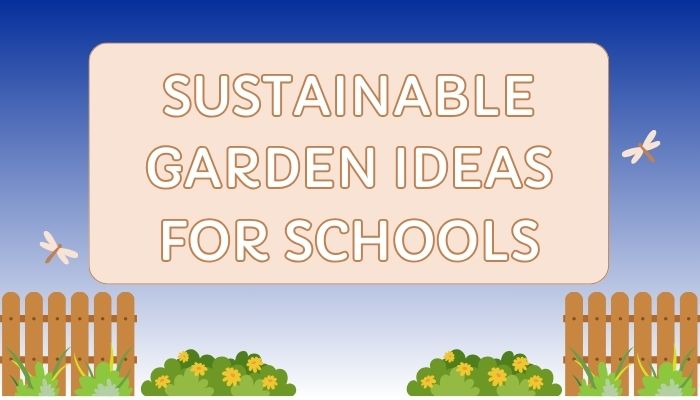Creating a sustainable garden at school is a fantastic way to foster a connection with nature, teach students about environmental responsibility, and offer hands-on learning opportunities. With a little creativity and effort, school gardens can become a vibrant hub for learning about ecology, sustainability, and community building. Here are 10 sustainable garden ideas for schools that can inspire students and promote long-term environmental benefits.
1. Build Raised Planter Beds
Raised planter beds are an excellent sustainable option for school gardens. They reduce soil compaction and drainage issues, making it easier to control the garden environment. These beds can be made from recycled materials, such as old wooden pallets or even large containers, promoting sustainability by reducing waste. Involve students in designing and building the beds, which can also serve as a great team-building exercise.
2. Implement a Rainwater Harvesting System
Water conservation is a crucial aspect of sustainability. Schools can install a rainwater harvesting system by placing barrels to collect rainwater from roofs. Students can help build or decorate these rain barrels, making it a creative, engaging activity while conserving water. Using collected rainwater to irrigate the garden reduces the school’s reliance on municipal water sources and cuts down on water waste.
3. Create a Composting Area
Composting is one of the best ways to practice sustainability. A composting area allows students to recycle kitchen scraps, garden waste, and leaves into nutrient-rich compost. This reduces waste and provides valuable organic matter that improves soil health, naturally fertilizing the garden without chemical additives. Students can take turns managing the compost pile, learning about decomposition and the importance of reducing landfill waste.
4. Grow Native Plants
Choosing native plants is key to creating a sustainable garden, as these species are adapted to the local climate and require less water, fertilizers, and pesticides. Students can research plants that are indigenous to the area and choose which ones to grow. This not only promotes sustainability but also helps local ecosystems thrive by attracting pollinators like bees and butterflies.
5. Design a Pollinator Garden
Encouraging biodiversity is essential for a sustainable garden. By planting pollinator-friendly plants, such as wildflowers, lavender, or sunflowers, schools can attract bees, butterflies, and birds. Students can track which pollinators visit their garden and learn about the importance of these creatures in food production and ecosystem health. They can even create small habitats, like bee hotels, to support local wildlife.
6. Incorporate Vertical Gardening
If your school has limited space, vertical gardening is a great way to maximize planting areas. Using recycled items like plastic bottles or pallets, students can create vertical planters that take up minimal ground space. Not only is this method sustainable and space-efficient, but it also adds a visually interesting element to the garden. Students can experiment with different plants and herbs to grow in the vertical space.
7. Establish a Seed-Saving Program
A seed-saving program teaches students about the life cycle of plants and promotes long-term sustainability. After harvesting, students can collect seeds from fruits, vegetables, and flowers grown in the garden to plant for the next season. This practice reduces the need to purchase new seeds, promotes biodiversity, and allows students to take ownership of the garden’s future.
8. Introduce Companion Planting
Companion planting is an eco-friendly technique where different plants are grown together to enhance each other’s growth or to protect against pests. For example, marigolds can be planted with tomatoes to repel insects, while beans can provide nitrogen to the soil for leafy vegetables. Students can experiment with various companion planting combinations and learn about natural ways to protect crops without using harmful chemicals.
9. Create Sensory Gardens
A sensory garden engages all the senses, making it an inclusive space for students of all abilities. These gardens are designed to stimulate touch, sight, smell, and sound through various plants and materials. For instance, lavender or mint provides a strong scent, while grasses create soft textures and rustling sounds in the wind. Students can explore their creativity by selecting plants that appeal to their senses, turning the garden into a therapeutic and interactive space.
10. Hold Eco-Friendly Garden Workshops
To build awareness and enthusiasm for sustainable gardening, schools can host eco-friendly garden workshops for students, staff, and parents. These workshops could focus on topics like organic gardening, waste reduction, or upcycling materials into planters. Encouraging the broader community to get involved in the garden fosters a sense of ownership and ensures that the sustainability efforts continue to grow.
FAQs About Sustainable School Gardens
1. How can students participate in maintaining the garden? Students can rotate through various roles such as watering, weeding, composting, and harvesting. Engaging them in every aspect of the garden’s maintenance builds responsibility and gives them a sense of pride in the garden’s success.
2. What are some eco-friendly materials that can be used in school gardens? Recycled materials like old tires, pallets, or containers can be repurposed as planters. Organic materials like wood chips, compost, and mulch can improve soil health and retain moisture.
3. How can a garden help teach sustainability? Gardens teach sustainability by showing students how to grow food, conserve resources like water, and reduce waste through composting. Students learn firsthand the importance of biodiversity, eco-friendly practices, and environmental stewardship.
4. Is it expensive to start a sustainable garden in schools? Not necessarily. By using recycled materials, growing native plants, and implementing water-saving techniques like rain barrels, schools can minimize costs. Involving the community through donations of tools, seeds, and materials can further reduce expenses.
5. How can school gardens support local wildlife? Planting native species, creating pollinator gardens, and building habitats like birdhouses or bee hotels provide essential resources for local wildlife. These efforts help maintain biodiversity and create a living, dynamic learning space for students.


